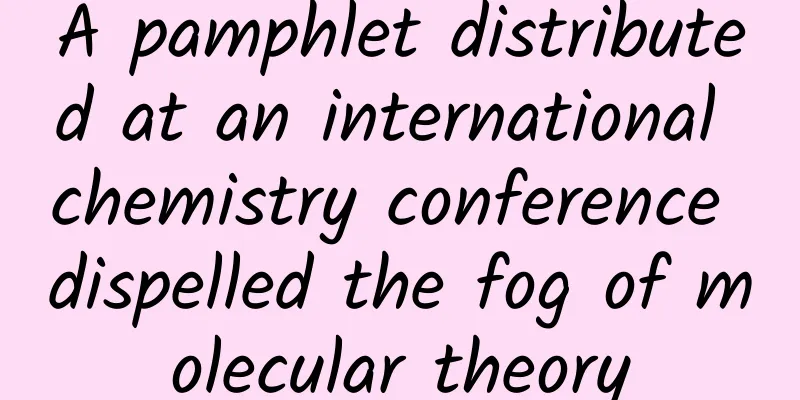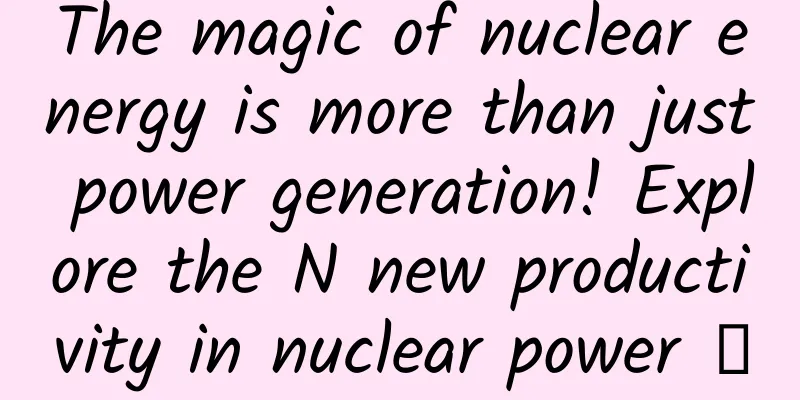A pamphlet distributed at an international chemistry conference dispelled the fog of molecular theory

|
People today seem to be getting more and more accustomed to atoms and molecules, but they ignore that these concepts are not taken for granted. It took a century for atoms and molecules to go from speculation to science. The smooth road under our feet was also full of detours. The full article will be divided into two parts, this article is the first part, which introduces the origin and development of modern atomic and molecular theory in the field of chemistry from Dalton, Avogadro to Cannizzaro. Written by Zheng Chao (Researcher at Shanghai Institute of Organic Chemistry, Chinese Academy of Sciences) Every little fact leads you to a new theory; Every bit of theoretical thinking prompts you to discover unseen facts. Jac. Berzelius Bref (1914), i, Part 3 Speaking of atoms and molecules, readers must be familiar with them. Any high school physics or chemistry textbook will mention that atoms are the basic particles that make up matter. Atoms are connected to each other according to certain rules to form the smallest unit that maintains the chemical properties of matter - molecules. From the extended reading materials of the textbook, you can also learn about the main founders of modern atomic and molecular theories: the British Dalton (J. Dalton, 1766-1844) and the Italian Avogadro (A. Avogadro, 1776-1856). In today's chemical laboratories, we can use X-ray diffraction technology to determine the three-dimensional structure of molecules in crystals; using scanning tunneling microscopes, we can observe and even manipulate atoms on the surface of solid materials. However, if you are more curious, it will not be difficult to find the fact that the invention of these two methods of characterizing the structure of matter was much later than the life of Dalton and Avogadro. So, without the help of advanced instruments, what kind of reasoning and experiments did the pioneers more than a hundred years ago rely on to determine the existence of atoms and molecules and detect bursts of spring thunder coming from the microscopic world that could not be directly reached by the senses in the invisible and intangible "fog"? “Grafting” that breaks through barriers The idea of atoms and molecules has a long history, as can be seen from their etymology. The English word "atom" comes from the Greek word ἄτομον, which means indivisible; "molecule" comes from the Latin word mōlēcula, which means a small pile of matter. Ancient Greek thinkers Leucippus, Democritus and Epicurus all held the view that matter is composed of indivisible particles, but their arguments obviously cannot escape the scope of transcendental philosophical speculation. The scientific revolution that followed the Renaissance gave atomism new vitality. The great success of classical mechanics made natural philosophers in the 17th century generally believe that the movement of macroscopic objects must be attributed to the properties and interactions of particles that are invisible to the naked eye. The most representative example comes from Newton, who found that if the gas is regarded as an elastic fluid composed of mutually repelling particles, and the repulsive force decreases rapidly as the distance between the particles increases, such a gas will obey Boyle's experimental law (the pressure of the gas at a constant temperature is inversely proportional to the volume). At the end of his masterpiece "Optics", Newton clearly put forward the hypothesis that matter is composed of moving particles with a certain mass and impenetrable, and hoped to use this as a basis to explain complex chemical changes. However, Newton also admitted that he could not prove this particle hypothesis by experiment; the task of sublimating atomic theory from mental gymnastics to scientific theory can only be left to future generations. It was Dalton who took a decisive step in the direction pointed out by Newton. Dalton was born into a poor peasant family in northern England 40 years after Newton's death. He was extremely intelligent since childhood, but he was unable to receive systematic college education and relied entirely on self-study to become a talent. Dalton never married and did not care about fame or fortune. He used the meager income from his teaching to maintain a simple life. He "slept at midnight and got up at dawn" and devoted all his energy to the exploration of science. His research fields involved meteorology, physics and chemistry. Dalton made meteorological observations every morning from the age of 21 until the day before his death, which lasted for 57 years. The first-hand information on temperature, air pressure, humidity, etc. accumulated over a long period of time became an important basis for his research on the properties of gases. J. Dalton (1766~1844) By the end of the 18th century, people had separated oxygen, nitrogen, carbon dioxide and other gases from the air and measured their densities. A natural and puzzling question is why these components can be mixed into uniform air without being stratified according to their respective densities? In addition, Dalton discovered the law of partial pressure of gases through experiments, that is, the total pressure of a mixed gas is equal to the sum of the pressures of all components. Dalton followed Newton's idea and believed that considering gas as an elastic fluid composed of atoms with specific masses was a feasible solution to explain the above facts. However, due to the influence of the "caloric theory" popular at the time, Dalton's atoms were surrounded by a layer of massless heat flow, just like a hard ball wrapped in cotton. Dalton further assumed that the heat flows of atoms of the same kind repel each other and the heat flows of atoms of different kinds do not interact with each other. In this way, atoms of different gases can shuttle between each other's heat flows, thereby achieving uniform mixing; the repulsion only occurs between the heat flows of the same gas, which "guarantees" the establishment of the law of partial pressure. Figure 1. (Left) Dalton's book "Essays on Meteorological Observations", whose title page quotes the ancient Roman poet Horati Flacci's poem Est quadam prodire tenus, si non datur ultra, which roughly means "If you can't go further, you can always reach a certain point"; (Right) Dalton's atomic model (the lines radiating from the center represent the heat flow around the atoms), in which the models numbered 1, 13 and 5 represent hydrogen, oxygen and water "atoms" respectively What really made Dalton surpass Newton and all previous atomists was that he cleverly "grafted" the atomic theory of physics with the mass ratio of elements in chemical reactions. Dalton proposed the famous law of multiple ratios: when two elements A and B can combine to form different substances, the mass of element B combined with a certain mass of element A in these substances is a simple integer ratio. For example, both biogas (methane) and oil gas (ethylene) contain only two elements, carbon and hydrogen. If the mass of carbon in the two gases is used as the benchmark, the mass of hydrogen in biogas is twice that of oil gas; similarly, the mass ratio of carbon to oxygen in carbon oxide (carbon monoxide) is 3:4, while this ratio in carbon dioxide is exactly 3:8. Dalton was keenly aware that the use of atomic theory can perfectly explain this discovery. Since atoms are indivisible, the combination of elements must be based on their own atoms as the smallest unit. Doesn't the simple multiple relationship of the mass ratio of elements in different substances correspond exactly to the difference in the number of atoms involved in the combination? Taking this discovery as a starting point, Dalton creatively proposed a method to calculate the relative mass (atomic weight) of atoms. Take oxygen as an example. At that time, people knew that water was composed of only hydrogen and oxygen through water electrolysis experiments and hydrogen combustion experiments. Based on a "simplest ratio" principle, Dalton inferred that water was a binary compound of hydrogen and oxygen, and its chemical formula (expressed in today's notation) was HO. The atomic weight of hydrogen was set to 1, and the atomic weight of oxygen could be calculated based on the mass fractions of hydrogen and oxygen in water measured experimentally. If Lavoisier's value is used (the mass fractions of hydrogen and oxygen are 15% and 85% respectively), the atomic weight of oxygen can be determined to be 5.7 (≈ 85/15); if Gay-Lussac and von Humboldt's values are used (the mass fractions of hydrogen and oxygen are 12.6% and 87.4% respectively), the atomic weight of oxygen is 7 (≈ 87.4/12.6). In September 1803, Dalton wrote the first atomic weight table in his experimental log. In October of that year, Dalton first made public his atomic theory and atomic weight table in a paper read to the Manchester Philosophical Society. In 1808, Dalton published his famous book "A New System of Chemical Philosophy". In the second part of the book, he used atomic theory to explain the composition and properties of basic elements and two-element compounds. From today's perspective, Dalton's atomic theory has too many flaws. His belief in the caloric theory is a completely wrong theory, and the way to determine the chemical formula of substances is also arbitrary; his experimental technology is not advanced, and the atomic weights he collected (even if converted into the correct chemical formula) have large errors. But this does not diminish Dalton's position in the history of science. "Atomic theory" is ancient, but Dalton was the first to jump out of the barriers of philosophical speculation, using the viewpoint of atomic theory to explain the chemical composition of substances, and using observable experimental phenomena to prove the existence of atoms. As H. Davy, then president of the Royal Society of London, pointed out, the scientific atomic theory proposed by Dalton was comparable to Kepler's achievements in astronomy. He deserves the reputation of "the father of modern chemistry" praised by Engels. The confusion As soon as Dalton's atomic theory came out, it attracted widespread attention from chemists, but it also faced severe challenges. The core of the problem was that the atomic weights calculated by Dalton strongly relied on unproven chemical formulas. Theoretical: A sphere can be in contact with at most 12 spheres of the same size (like oranges stacked in a fruit store). Although Dalton's "simplest ratio" principle has a certain formal beauty, it is inconsistent with many experimental facts. The most famous contradiction comes from the simple volume ratio of hydrogen and oxygen discovered by Gay-Lussac and Humboldt. Gay-Lussac was a leading French physicist and chemist in the early 19th century. He studied under CL Berthollet, a close collaborator of Lavoisier, and inherited his teacher's teachings. Gay-Lussac's most famous achievement is the physical law named after him: the volume of a gas expands linearly with increasing temperature under constant pressure. In 1804, Gay-Lussac flew twice in a hot air balloon (the first time with physicist JB Biot) to study the variation of atmospheric temperature, humidity and the geomagnetic field with altitude. He was the first person in history to reach an altitude of 7,000 meters. Top: JL Gay-Lussac (1778-1850); Bottom: JJ Berzelius (1779-1848) Shortly after the balloon expedition, Gay-Lussac and German naturalist Humboldt worked together to study the reaction of hydrogen and oxygen. Using the voltaic tube (a certain volume of hydrogen and oxygen mixed gas is sealed in an inverted long tube with mercury, and then an electric spark is used to induce the hydrogen and oxygen reaction. The decrease in the volume of the mixed gas is measured by the rise of the mercury liquid level after the reaction is completed), they found that the chemical reaction of the gas follows a simple volume ratio: At a certain temperature and pressure, 2 volumes of hydrogen and 1 volume of oxygen react to produce 2 volumes of water vapor. This simple mathematical relationship immediately makes us realize that volume can be used as a unit of measurement for gases participating in chemical reactions. If we admit that chemical reactions are carried out with atoms as the basic unit, it is not difficult to draw the following inference: "At a certain temperature and pressure, the number of atoms in the same volume of any gas is equal." Perhaps out of protection for his teacher (Berthollet always opposed the view that different elements react chemically in a certain stoichiometric ratio), Gay-Lussac himself did not elaborate on the significance of the volume ratio of hydrogen-oxygen reaction, but the result of this experiment had a significant impact on Dalton. From today's perspective, it is easy for us to agree that the statement that "the number of atoms of the same volume of gas is equal" supports both the law of partial pressure of gases and the atomic theory to a certain extent; but Dalton did not buy it, and instead questioned the accuracy of the experimental results of Gay-Lussac and Humboldt. For Dalton, water, as a "compound atom" of hydrogen and oxygen, should have a greater atomic weight than oxygen (Dalton believed that the chemical formula of water is HO and the chemical formula of oxygen is O). If it is admitted that "the number of atoms of the same volume of gas is equal", then the density of water vapor will also be greater than that of oxygen, which is obviously inconsistent with the facts. Therefore, Dalton insisted that since the atoms are surrounded by massless heat flow, the experimentally measured gas density (macroscopic property) cannot be directly linked to its atomic weight (microscopic property), and the number of atoms contained in the same volume of different gases does not have to be equal. What’s more serious is that if the reaction equations of hydrogen and oxygen are balanced according to the volume ratios of Gay-Lussac and Humboldt, then “half an oxygen atom” must appear in the chemical formula of water: Figure 2. (Left) Painting depicting Gay-Lussac and Biot taking off in a hot air balloon; (Right) Stamp commemorating Berzelius Berzelius's scientific career began with his research on electrochemistry. Electrolysis was an important means for chemists at the time to understand the composition of complex substances. Berzelius noticed that in electrolysis experiments, some substances always precipitated from the cathode and others from the anode, which made him believe that the combination of substances was due to the mutual attraction of different charges. Berzelius further linked the electrical properties of substances with acidity and alkalinity, and constructed his theoretical system for the classification of inorganic substances - electrochemical dualism. He classified electronegativity as Affected by the Napoleonic Wars, the communication between scientists in various European countries in the early 19th century was not smooth. Berzelius did not know Dalton's work when he obtained the above results. He first learned about Dalton's theory from the article of British chemist WH Wollaston in 1809, but it was not until 1812 that he received the book "A New System of Chemical Philosophy" sent to him by Dalton. In a letter to a friend, Berzelius said, "No gift would please me more than this book, but I also do not hide my disappointment in its author." Although Berzelius greatly appreciated Dalton's atomic theory, he was quite dissatisfied with the crudeness of his experimental data. From 1814, Berzelius began his own atomic weight calculation work. He set the atomic weight of oxygen to 100, and then used the composition analysis results of thousands of inorganic substances he had accumulated, combined with the law of "isomorphism", and calculated the atomic weights of 45 of the 49 elements known at that time. Berzelius was the most outstanding inorganic and analytical chemist in the first half of the 19th century. His experiments were known for their detailed and reliable data. He invented the method of using elements Table 1. Values of various atomic weights in the early 19th century The calculated values of the atomic weights of metals are 2 or 4 times the correct values. In addition to Dalton and Berzelius, David, Wollaston, Thomson (T. Thomson, British chemist), Prout (W. Prout, British chemist) and others have calculated the atomic weights of common elements. Although the calculation principles are basically the same, the experimental results they adopted are not completely consistent, and the chemical formulas of some key substances they are based on are also different, so the calculation results are often contradictory. This chaotic situation has a very adverse impact on the development of atomic theory. Some conservative chemists choose to abandon the illusory "atoms" and continue to use concepts such as "equivalent weights" that are more closely related to experiments to describe the composition and chemical reactions of substances. History played a joke on chemistry here. The chemists in the 1820s did not know that the key to solving the puzzle had already appeared, and the correct use of this key would not become widely known until a special occasion decades later. The “no-effort” consensus In 1828, Berzelius' German student F. Wöhler used inorganic substances such as cyanate and ammonia to prepare the organic substance urea, breaking the myth that the synthesis of organic matter must rely on "vitality" and opening the prelude to modern organic chemistry. Although organic matter is composed of only a few elements such as carbon, hydrogen, oxygen, and nitrogen, there are many types and the content ratio of elements varies. Due to the lack of recognized atomic weights and methods for determining the chemical formula of substances, according to statistics from scholars at the time, even a simple organic substance like acetic acid has as many as 19 different chemical formulas! In order to reverse this chaotic situation, an unprecedented international chemical conference was held in the southern German city of Karlsruhe from September 3 to 5, 1860. The Karlsruhe Conference was initiated by German chemists FA Kekulé and C. Weltzien and French chemist CA Wurtz. More than 140 chemists from 15 European countries attended the conference, making it the first international academic conference in history. Although a long discussion took place, the conference did not reach any resolution on its original intention - the basic concepts of material composition and chemical reactions - because the participants opposed the "democratic" method of voting by raising their hands. However, on the last day of the conference, Italian chemist S. Cannizzaro distributed a book of lecture notes he had written for students at the University of Genoa two years ago, "Summary of a Course in the Philosophy of Chemistry", which used rigorous logic and clear expression to clarify the most core and difficult problems in chemical research at the time. Upper: A. Avogardro (1776-1856); Lower: S. Cannizzaro (1826-1910) Cannizzaro's life experience was tortuous and rich. He grew up in Sicily, Italy. In his early years, he participated in the Sicilian Independence Revolution against the rule of the Bourbon dynasty and served as an artillery officer. Later, he went to many places in Italy and France to study and engage in chemical research. He discovered the famous Cannizzaro reaction in organic chemistry (benzaldehyde disproportionates to form carboxylic acids and alcohols under strong alkaline conditions). The most important thing Cannizzaro left in the history of chemistry was the spread of molecular theory at the Karlsruhe Conference. This theory originated from a paper published by his Italian predecessor Avogadro in 1811. Avogadro was 50 years older than Cannizzaro and was a contemporary of Dalton, Gay-Lussac and Berzelius. He was born into a prominent judge's family. He worked as a lawyer for many years when he was young. He began to study natural sciences at the age of 30 and later served as a professor at the University of Turin in his hometown for a long time. Avogadro was on the fringes of French academic circles and was not well-known in the English-speaking world during his lifetime (several important contributors to atomic theory in the early 19th century were British or closely connected to British academia). Avogadro's molecular theory was not recognized for nearly half a century after it was proposed, but he did not mind. He lived a quiet life with his family for most of his life. Avogadro studied the experimental results of Gay-Lussac and Humboldt on the reaction of hydrogen and oxygen. He supported the idea of using volume as a unit of measurement for the gas involved in chemical reactions. Avogadro proposed that if equation (1) is rewritten as equation (3), That is, multiplying the number of atoms in the chemical formulas of the three substances by 2 can avoid the embarrassment of "half an oxygen atom" and conform to the volume ratio determined experimentally; the price paid is to admit that the particles of hydrogen and oxygen (which Avogadro called "constituent molecules", molécule constituante) are composed of two identical smaller particles (which Avogadro called "elementary molecules", In chemical reactions, molecules can be divided and reassembled, but atoms cannot. Thus, the statement that "the number of atoms in the same volume of gas is equal at isothermal and isobaric conditions" was naturally revised to the number of molecules in the same volume of gas is equal at isothermal and isobaric conditions (today known as Avogadro's law). Since oxygen is regarded as a diatomic molecule, its density is greater than that of water vapor even under the constraints of Avogadro's law. The change from (1) to (3) seems insignificant and reconciles the contradictions of all parties, but it was still a great offense at the time. Because neither Dalton's heat flow atomic model nor Berzelius's electrochemical dualism allows mutually repelling atoms of the same type to directly combine. Although the heat flow atomic model had few followers, the electrochemical dualism was widely used in the classification and component analysis of inorganic substances, and was even regarded as a golden rule. Therefore, although a view similar to Avogadro's was later re-proposed by the great French scientist AM Ampère, it has never received due attention. Figure 3. Avogadro's manuscript of his 1811 paper. The arrow points to the beginning of his discussion of molecules. Image source: Amedeo Avogadro, A Scientific Biography The reason why the molecular theory made a big step forward in the hands of Cannizzaro was that he established a complete logical chain for deriving the molecular weight, molecular formula and atomic weight of substances based on the two macroscopically measurable properties of substance vapor density and element mass ratio. He set the atomic weight of hydrogen (H) to 1, and based on Avogadro's interpretation of the volume ratio of hydrogen-oxygen reaction, the molecular weight of hydrogen (H2) was 2. As long as it is recognized that the number of molecules of the same volume of gas is equal under isothermal and isobaric conditions, the vapor density of a substance can be used as a measure of its molecular weight. By comparing the density of a series of gaseous substances with the density of hydrogen, their molecular weights can be inferred. For example, oxygen is 32, carbon oxides and carbonic acid are 28 and 44 respectively, chlorine is 71, hydrochloric acid gas is 36.5, mercury vapor is 200, calomel and mercuric chloride vapor are 235.5 and 271 respectively. Note that the contribution of each element in a molecule to the molecular weight must be an integer multiple of its atomic weight, so according to the mass ratio of each element in the substance, its chemical formula and the atomic weight of the corresponding element can be determined. Figure 4. Cannizzaro's molecular formula, molecular weight and reaction equation for chlorides are very close to today's notation. Image source: Sketch of a Course of Chemical Philosophy Since the vapor density and elemental composition of organic matter can usually be measured relatively easily, Cannizzaro's method quickly dispelled the doubts surrounding the chemical formula of organic matter and gave a definite and self-consistent answer. For substances whose vapor density could not be measured, Cannizzaro used the Dulong–Petit law on the specific heat of crystals to assist in determining the total number of atoms in the chemical formula, and was able to obtain satisfactory results. "After searching everywhere for something, I found it without any effort." Cannizzaro's brilliant reasoning, like mercury flowing out of the ground, conquered many participants who were about to leave Karlsruhe. German chemist JL Meyer exclaimed that "the original confusion was stripped away in an instant." Since then, there has been no obstacle to applying the concepts of atoms and molecules to the study of material composition and chemical reactions, and various conflicts about the numerical value of atomic weight have been resolved. The young Russian chemist DI Mendeleev - he was just an unknown overseas student at the Karlsruhe Conference - arranged the different elements in order from small to large atomic weight, and finally published the great periodic law of elements nine years later. To be continued From Dalton, Avogadro to Cannizzaro, modern atomic and molecular theories finally gained a solid place in the chemical theory system after experiencing confusion and chaos in the first half of the 19th century. However, are atoms and molecules really tiny entities that exist objectively? Or are they just ideal models constructed by humans? More exploration and debate will unfold outside of chemistry around this question. It has spawned new disciplines, revolutionized people's cognition, and shaped the underlying logic of 20th century science... Acknowledgements The authors would like to thank Academician You Shuli from the Shanghai Institute of Organic Chemistry, Chinese Academy of Sciences, Researcher Cao Zexian from the Institute of Physics, Chinese Academy of Sciences, Professor Zhang Shaodong from Shanghai Jiao Tong University, and Researcher Liu Jinyan from the Institute of the History of Natural Sciences, Chinese Academy of Sciences for their valuable comments on this article. About the Author Dr. Zheng Chao is a researcher at the Shanghai Institute of Organic Chemistry, Chinese Academy of Sciences, and a recipient of the National Natural Science Foundation of China Excellent Young Scientist Fund Project. His research interests are physical organic chemistry and chiral synthesis. Special Tips 1. Go to the "Featured Column" at the bottom of the menu of the "Fanpu" WeChat public account to read a series of popular science articles on different topics. 2. Fanpu provides a function to search articles by month. Follow the official account and reply with the four-digit year + month, such as "1903", to get the article index for March 2019, and so on. Copyright statement: Personal forwarding is welcome. Any form of media or organization is not allowed to reprint or excerpt without authorization. For reprint authorization, please contact the backstage of the "Fanpu" WeChat public account. |
Recommend
Internet access is expensive, so let the operators decide for themselves.
[[131858]] The reporter found yesterday that ...
Top 5 Best HTML5 Frameworks in 2015
Most of the web developers have been looking for ...
A zero-cost online earning project with no threshold, integrating WeChat groups to realize multiple monetization and earning 300+ per day
A zero-cost online earning project with no thresh...
How to play brand marketing, the 4 core basic skills you must master
What is Marketing ? Marketing is a means of satis...
Is the universe starting to produce "raspberries"? In fact, it is a newly discovered supernova remnant! | Expo Daily
Is the universe starting to produce "raspber...
Li Zhongying talks about the difference between heaven's law and human's law, the way to a happy life, high-end thinking skills course video + document
Li Zhongying talks about the difference between h...
Suning, Banma Network, and Huawei gathered at the Guangzhou Auto Show to promote GAC Aion
On November 20, the 18th Guangzhou International ...
The most complete in history! Summary of online marketing and promotion channels! One picture is enough, I saved it
Introduction: This article divides the nine commo...
How to plan a complete online event? Here is a complete plan
Why is it that with the same budget, the final re...
"Mars opposition" is happening today! Don't miss the best time to observe "Mars".
It's a good time to observe Mars. Astronomy e...
How the expansion of mobile screen size affects user experience design
The era of small-screen phones with various shape...
Be careful! What are the "live pearls" that are popular on the Internet? Can they be eaten?
recent A food called "live beads" Going...
China's first! Officially released
Recently, my country's first desktop operatin...
Can Ang Lee's 120-fps "Billy Lynn's Long Halftime Walk" recreate the myth of "Avatar"?
Do you remember the grand occasion when the movie...
This type of cancer is often diagnosed in the middle or late stages! Women must do this examination after the age of 30!
Recently, at the National Breast Cancer Conferenc...









